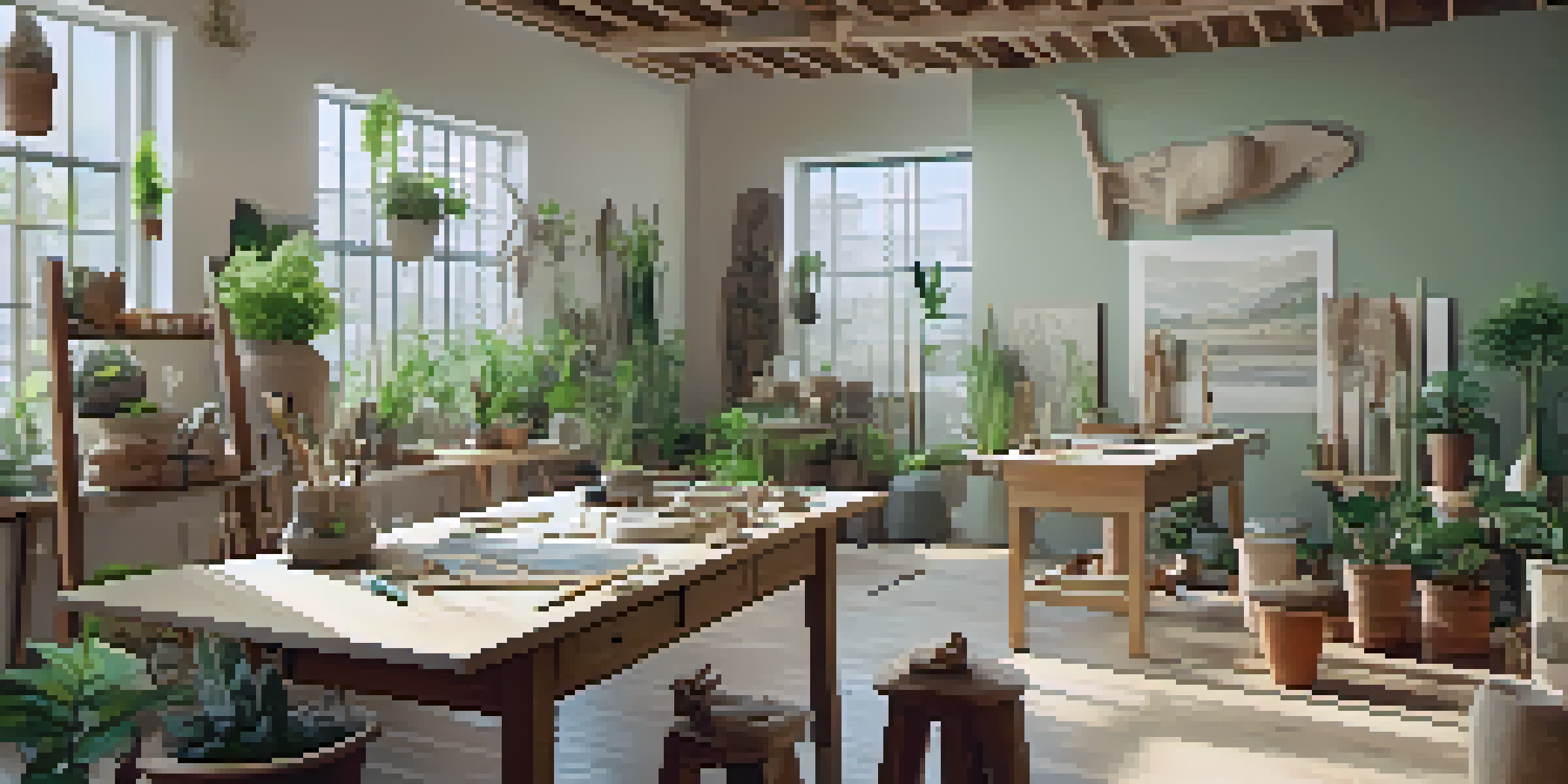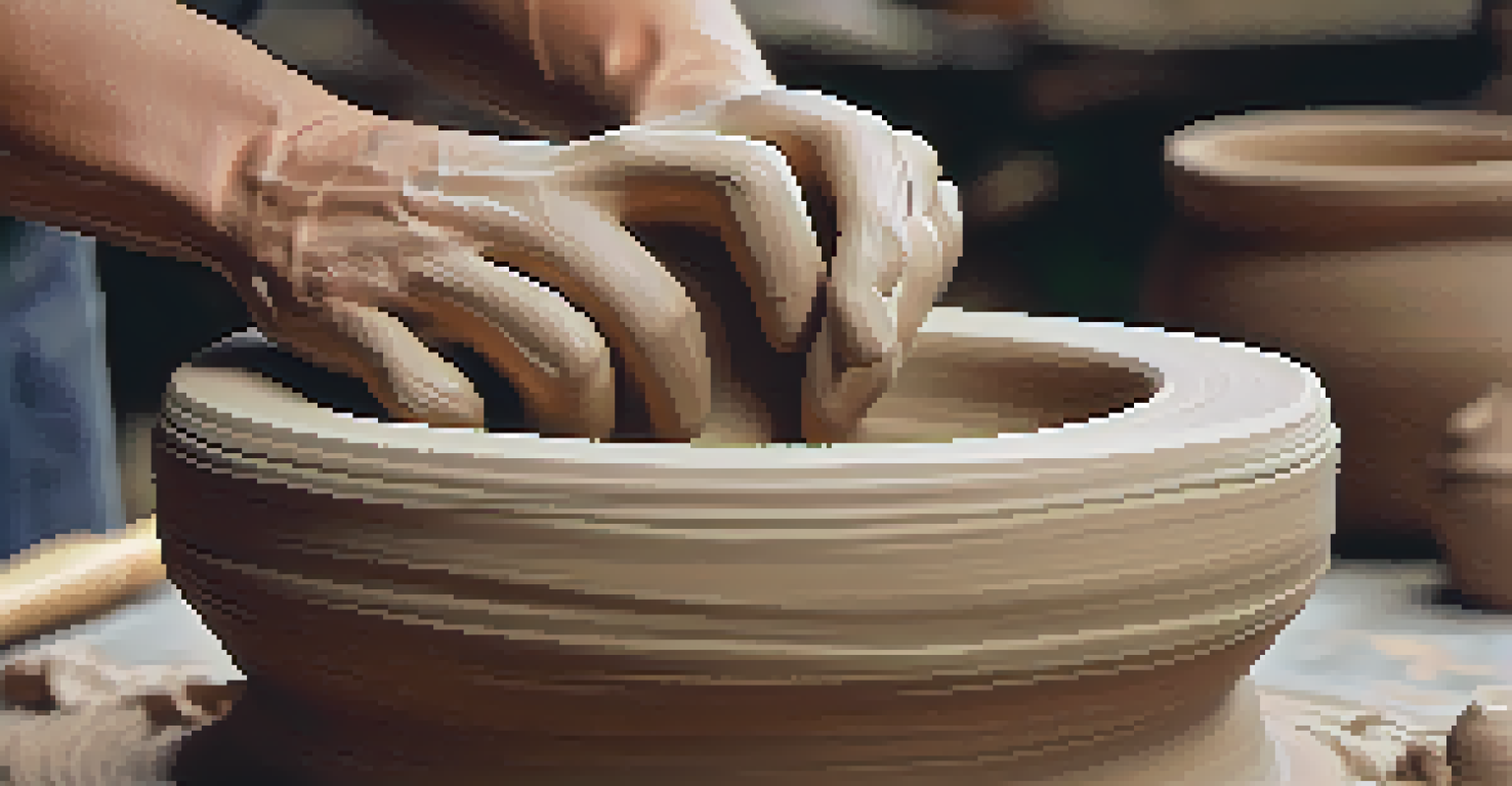The Psychology Behind Sculpting: Expressive Art Therapy

Understanding Art Therapy and Its Benefits
Art therapy is a form of psychotherapy that encourages creative expression to help individuals process their emotions. By engaging in various forms of art, including sculpting, people can delve into their subconscious and unveil feelings that might be difficult to articulate. This therapeutic approach is particularly beneficial for those facing trauma, anxiety, or depression, as it provides a non-verbal outlet for emotions.
Art enables us to find ourselves and lose ourselves at the same time.
Sculpting, in particular, offers a tactile experience that can be grounding and calming. The act of molding clay or carving stone allows individuals to channel their feelings into a physical form, making it easier to confront and understand them. This process not only fosters emotional release but also enhances self-awareness and personal growth.
Moreover, the benefits of art therapy extend beyond emotional healing. Participants often report an increase in self-esteem and confidence as they create tangible representations of their thoughts and feelings. Sculpting allows individuals to see their progress and achievements, reinforcing a sense of accomplishment that can be empowering.
The Science of Creativity and Emotional Expression
Engaging in creative activities like sculpting triggers various psychological responses that can lead to emotional healing. When individuals create art, their brains release dopamine, a neurotransmitter associated with pleasure and reward. This chemical reaction not only boosts mood but also encourages further exploration of one's creative capabilities.

Additionally, the process of sculpting often requires intense focus, which can act as a form of mindfulness. This concentration helps individuals shift their attention away from negative thoughts and stressors, promoting a sense of calm. By immersing themselves in the art-making process, sculptors can find a therapeutic escape from their everyday challenges.
Art Therapy Enhances Emotional Healing
Engaging in sculpting as a form of art therapy allows individuals to process and express complex emotions in a non-verbal way.
Creativity, therefore, is not just a means of self-expression; it can also be a pathway to understanding and processing complex emotions. As individuals engage with their craft, they may uncover deeper insights about themselves and their experiences, leading to personal revelations and healing.
Sculpting as a Form of Non-Verbal Communication
For many, expressing emotions verbally can be challenging. Sculpting provides a unique alternative by allowing individuals to convey their feelings through form and texture instead of words. This non-verbal communication can be especially beneficial for those who struggle with language or have experienced trauma that makes vocal expression difficult.
Every artist dips his brush in his own soul, and paints his own nature into his pictures.
Through the manipulation of materials, sculptors can create representations of their inner worlds. For instance, a rough, jagged sculpture may signify turmoil, while a smooth, flowing piece might reflect serenity. This artistic language enables individuals to communicate complex emotions in a way that feels safe and accessible.
Moreover, sharing these sculptures with others can foster connection and understanding. When individuals present their artwork, they invite others into their emotional landscape, facilitating conversations that may not have been possible otherwise. This exchange can enhance relationships and promote empathy among peers, further supporting the healing process.
The Role of Environment in Sculpting Therapy
The environment in which sculpting takes place plays a vital role in the therapeutic process. A supportive and nurturing space allows individuals to feel safe as they explore their emotions through art. Whether it's a quiet studio or a vibrant community center, the atmosphere can significantly influence creativity and emotional expression.
In addition, being surrounded by natural materials can enhance the sculpting experience. Working with clay, stone, or wood connects individuals to nature, which has its own healing properties. This interaction not only stimulates creativity but also promotes mindfulness, as sculptors become attuned to the textures and shapes of the materials they’re using.
Sculpting Promotes Mindfulness
The focus required during sculpting encourages mindfulness, helping individuals escape from negative thoughts and stressors.
Creating a dedicated space for sculpting can also help individuals establish a routine, making art a regular part of their self-care practices. By carving out time and space for creativity, individuals can develop a deeper relationship with their art, leading to ongoing emotional exploration and healing.
The Therapeutic Process: Stages of Sculpting
Sculpting therapy typically follows a process that includes several stages, each contributing to emotional exploration and healing. The initial stage involves gathering materials and allowing oneself to play without specific goals. This phase is all about freedom and experimentation, encouraging individuals to let go of any constraints and simply create.
As sculptors progress, they may begin to consciously express specific emotions or themes through their work. This stage often involves reflection and intention, as individuals consider what they wish to convey. By focusing on these emotions, sculptors can gain deeper insights into their feelings and experiences.
Finally, the last stage often includes sharing and discussing the artwork with a therapist or group. This sharing aspect can be incredibly powerful, as it allows for validation and support. By discussing the emotions tied to their sculptures, individuals can gain further clarity and understanding, solidifying their healing journey.
Overcoming Barriers: Sculpting for All Abilities
One of the beautiful aspects of sculpting as art therapy is its accessibility. Regardless of age or physical ability, anyone can engage in this expressive art form. Tools and materials can be adapted to suit different needs, ensuring that everyone has the opportunity to participate and benefit from the therapeutic process.
Moreover, the emphasis in art therapy is not on the final product but on the experience itself. This focus helps alleviate pressure and encourages individuals to explore their creativity without fear of judgment. The act of sculpting becomes a personal journey, allowing individuals to embrace their unique expressions.
Accessibility for All Abilities
Sculpting as art therapy is inclusive, allowing people of all ages and abilities to participate and explore their creativity without pressure.
By creating inclusive environments where everyone feels welcome, more individuals can discover the emotional benefits of sculpting. This inclusivity fosters community and connection, enhancing the overall therapeutic experience while breaking down barriers to self-expression.
Conclusion: The Lasting Impact of Sculpting Therapy
In conclusion, sculpting as a form of expressive art therapy offers profound emotional benefits. By engaging with materials and the creative process, individuals can explore their feelings in a safe and supportive environment. This unique blend of creativity and therapy promotes healing, self-discovery, and personal growth.
The impact of sculpting extends beyond the art itself; it fosters connections, enhances self-esteem, and encourages ongoing self-expression. Many participants find that the skills and insights gained through sculpting carry over into their daily lives, equipping them to handle challenges with greater resilience.

Ultimately, whether you’re a seasoned artist or a complete beginner, sculpting can serve as a powerful tool for emotional exploration. As more individuals discover the transformative power of art therapy, the potential for healing and connection continues to expand, making it a valuable resource for emotional well-being.